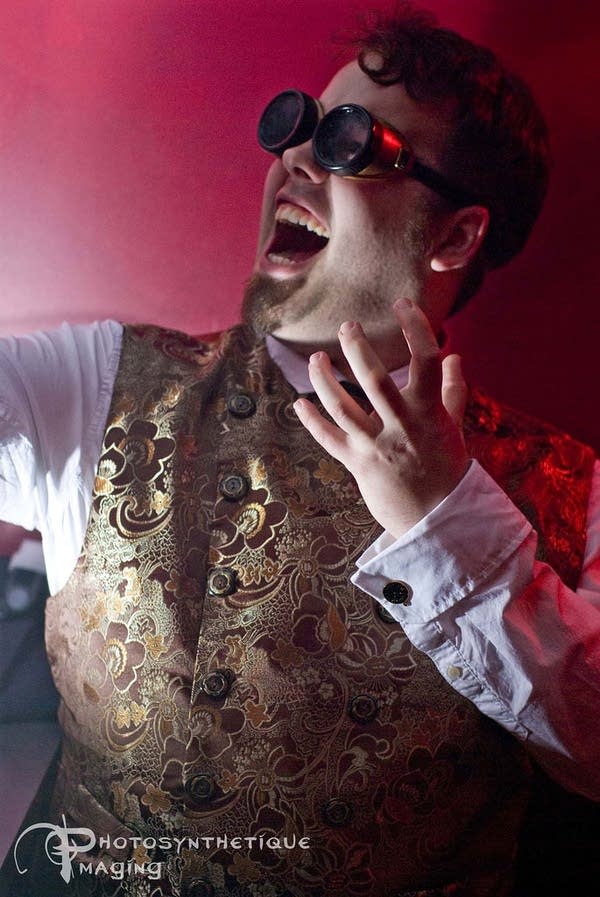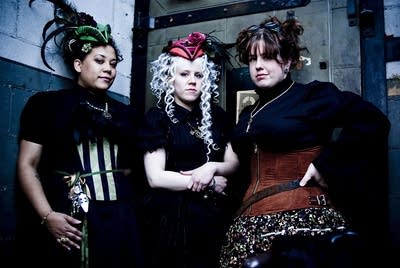More is more when it comes to neo-Victorian fashion
Go Deeper.
Create an account or log in to save stories.
Like this?
Thanks for liking this story! We have added it to a list of your favorite stories.

Let's begin with Lolita. Lolita fashion got it's start in Japan, where young girls meet up at Harajuku station in Tokyo every Sunday to show off their latest threads. It's inspired by Victorian children's clothing, featuring knee length skirts or dresses, petticoats, and knee high socks. Some girls accessorize their outfit with a Teddy Bear to complete the look.
But fashion designer Samantha Rei says don't confuse the girlish fashion trend with that famous book by Vladimir Nabokov. "Truth is a lot of the girls in Japan have never actually read the book," said Rei.

Rei's the creator of Blasphemina's Closet, and she has been designing her own line of Lolita clothing for several years. She says Lolita fashion took hold in Japan as a way for girls to break out of their regimented culture and enjoy being young while they still can. "These girls were like you know what? I kind of wanna be a little girl on the weekend," said Rei. "You know I can go to a tea party if I want to. I'm done with school for the week - I'm going to go eat candy and play with my girlfriends, and I'm not going to live for boys. It's very positive."
Rei sees the new interest in petticoats and lace as a sort of feminism, both for Japanese women, and here in the U.S. "Taking back the corset," if you will.
Turn Up Your Support
MPR News helps you turn down the noise and build shared understanding. Turn up your support for this public resource and keep trusted journalism accessible to all.
"For the last 10 to 15 years girls have been, pardon my language, just a little bit whore-y," said Rei. "And it's really frustrating to me to see these girls putting themselves out there and not wearing anything. You can be sensual and you can be sexy and beautiful and still cover yourself up!"
Lolita fashion has many different subdivisions. There's classic Lolita, which is modeled after a sort of Alice in Wonderland look. Then there's sweet Lolita, with lots of ribbons and bows, pearls and lockets.

And then there's Samantha Rei's favorite - Gothic Lolita, which finds inspiration in Wednesday Addams of the Addams family. Gothic Lolita girls wear lots of dark colors and accessorize with attitude. They may practice the domestic art of knitting, but if they do, they'll knit skulls into their scarves and claws on their mittens.
Recently, Samantha Rei and her Lolita friends were invited to attend a fashion show at a club in downtown Minneapolis. They soon realized it wasn't their scene, since much of what was on the runway featured little more than underwear and body paint.
Erin Warholm-Wohlenhaus is wearing a sweet Lolita outfit. "I'm wearing a skirt from 'Baby the stars shine bright' which is a green gingham with lots of bows and flowers on it," said Warholm-Wohlenhaus. "I'm also wearing a vintage dress under the skirt, and under that another blouse that I managed to find somewhere - it's a little more casual than what I usually wear. And layered with lots of pearls."
Designer Samantha Rei says layers are what makes Lolita fashion fun. She says eastern and western cultures have been volleying back and forth ideas, each taking the Lolita look, playing with it and making it their own.
You can be sensual and you can be sexy and beautiful and still cover yourself up!
While Americans can buy Japanese Lolita clothing online, Rei says the sizes and fittings don't correspond well to the more curvy, voluptuous Midwestern girl, and so Rei created Blasphemina's Closet. Now she has a small, but dedicated, clientele for her clothing.
This brings us to Steampunk. While Lolita gets it's inspiration from Victorian girlhood, Steampunk's roots are found in literature: books such as Jules Verne's "20,000 Leagues Under the Sea" and H.G. Wells "The Time Machine."
Heather Luca, creator of Scoundrelle's Keep, says she defines it as the past that never was. Luca specializes in corsets, and she creates outfits that are rooted in the Victorian era, but with her own modern additions, such as zippers.
She says Steampunk is what the Victorian era would have looked like if it had access to technology. Think of Zeppelin fighting ships and ornate ray guns. You can also see it in movies like "The League of Extraordinary Gentlemen" and "Sky Captain and the World of Tomorrow."

"A lot of people in steampunk will create whole personas that go along with a lot of what they wear," said Luca. "You'll find a lot of airship captains and mechanics and stuff. And I think it is that re-imagining of what our life could have been."
Those outfits tend to involve leather, goggles, top hats, and lots of skeleton keys and pocketwatches. You're most likely to find someone dressed in a full steampunk outfit at a science fantasy convention. But thanks to Heather Luca and Samantha Rei, Lolita and Steampunk devotees are banding together for regular meet and greets.
On a frigid Saturday night, about 20 or more folks put on their fanciest clothing and met at Clubhouse Jager in Minneapolis. They decided the dark wood interior and plush high-back chairs were the perfect backdrop to their Victorian outfits.
While Lolita fashion caters to women, Steampunk is very popular with men. Ryan Crossland is wearing black slacks, a nice formal shirt and shoes, and a double breasted vest that looks like it could be made of silk.
"I just like the look. It's very structured, very streamlined, very masculine," said Crossland, "as opposed to current fashion which is just oversized, loose baggy clothing that really lacks any kind of character."

Crossland says he doesn't wear his steampunk brand of clothing to work, but Victorian accents may sneak into his wardrobe through his cufflinks, or choice of tie.
He says he thinks the interest in Steampunk, and other subculture fashion trends, is a rebellion against the uniformity of today's fashion.
"I mean we all go to the store; we all buy the same brands and everybody looks the same." said Crossland, "Some people just got sick of it and decided they wanted to do something a little different. This aesthetic just appeals to a certain kind of person."
Sitting in her Minneapolis basement turned design office, Regina Davan makes a living filling orders from around the world for her steampunk inspired kilts and skirts.

Davon says she loves creating pieces of clothing that look lived in and otherworldly. She also also sees in Steampunk a nostalgia for simpler times. She points to the ipod.
"Nowadays technology is cool, because it's small, it's lightweight, and it's invisible," said Davan. "But it also can be neat for the exact opposite reasons. When you can see every bit of it move and shake and this gear turns this and that's how the whole thing works. Especially when it makes a sound, something that whirrs and clicks and buzzes and you can watch it change and move as it's running. I think that has a huge appeal."
Some die-hard steampunk fans will build wooden clawfooted cases for their laptops, or add on extra moving parts to their watches. Davan says what she really likes about steampunk fashion is that it encourages people to take creative control of their clothing and their lives.
"Even if the actual clothing isn't made from scratch, you can modify it on your own," said Davan. "You can add leather, you can sew things on, you can rivet things on. I mean the basic thing is people will modify the goggles. It's pretty classic steampunk - goggles on the top hat. Most people who have those built them themselves, and it may be the only craft they've done since they got out of school, but suddenly people are picking up tools again and building it."
Whatever the appeal of Steampunk and Lolita fashion, mainstream designers are paying attention. In recent years puffy sleeves and high collars have come back in style in department and retail stores. For a while Restoration Hardware was selling distinctly steampunk looking goggles, and designer Samantha Rei says she's even seeing bloomers for sale in the women's lingerie department. But she doesn't expect the trend to last.
"You'll see the influence for a year or two, and then it will go the next thing," said Rei. "I guess high fashion really wants to imitate subculture. I think they're envious of how creative we are."
While mainstream fashion may turn to other interests, Rei is confident Lolita and Steampunk clothing will have a dedicated niche market in the Twin Cities for years to come.



